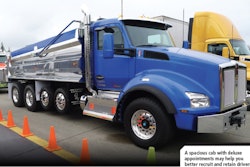When the roads get slippery, it’s time to take a conservative driving approach
Winter can bring with it a variety of adverse weather conditions from snow and ice to rain and fog. All of these unpredictable elements can make driving in winter challenging for everyone.
When winter rains and snows hit, reminding company drivers on the basics of winter driving is a good subject.
Adjusting Vehicle Speed
- Match your driving speed to the current conditions. If conditions are challenging due to a slippery road surface or reduced visibility, decrease your speed. A slower driving speed allows more time for a necessary response.
- Additional factors to consider when adjusting speed are the condition of the vehicle, its tires and your driving abilities. Always keep in mind the posted speed limits, and understand that those limits indicate the maximum speed when weather conditions are good.
- Plan ahead and try to anticipate potentially dangerous situations. When approaching a curve or potentially slick area of the road, use the brakes effectively.
- The brakes should be applied only before a curve and on a straight section of the road. Sometimes, taking your foot off the accelerator and allowing the vehicle to naturally slow without using the brakes is best.
Avoid Over-Confidence In Vehicle
Avoid overconfident driving, and avoid overestimating the vehicle’s capability simply because it is equipped with anti-lock brakes, four-wheel drive, traction control, winter tires or other safety devices.
Do not allow good judgment and smart driving to be overtaken by a false sense of security provided by vehicle technology.
 Accelerating the tow vehicle while keeping its wheels pointed straight is the best way to bring a sliding trailer under control according to winter driving experts.
Accelerating the tow vehicle while keeping its wheels pointed straight is the best way to bring a sliding trailer under control according to winter driving experts.Trailer Control In Snow
When a trailer starts sliding, accelerate to get it back in line while keeping the truck’s front wheels pointed straight ahead, says Mark Cox,Chief instructor/Bridgestone Driving School and head of Driving Sciences.
Cox says don’t turn into the skid as you would if the truck was sliding.
He also says getting around corners with a trailer in icy conditions is best done by “boxing off” or “V-ing off” the corners.
In other words, brake in a straight line before entering the corner, get all of the steering done at once while the trailer is responding, then accelerate out of the corner in a straight line.
Winter Tire Selection
Just because the vehicle you are driving is four-wheel or all-wheel-drive, its performance on slick roads depend on the tires.
One of the best ways to avoid slipping and sliding in a vehicle this winter is to improve the contact points between the vehicle and the road surface according to Steve Rohweder, Goodyear director of consumer tire technology.
“The bottom line for fleet managers is being aware of the severe winter driving conditions they might face,” says Rohweder. “Based on past experiences, do they feel their winter weather is moderate enough to choose a year-round tire, or are they mandated to use winter tires? Or do they face sometimes severe winter weather, and they prefer the peace of mind offered by true winter tires?”
“Preparation – of the vehicle and the driver – is the key for [safe] winter driving,” said Law. “When it comes to driving on the changing road conditions, ranging from dry, wet, icy and snowy, one of the most important factors to consider are the tires.












